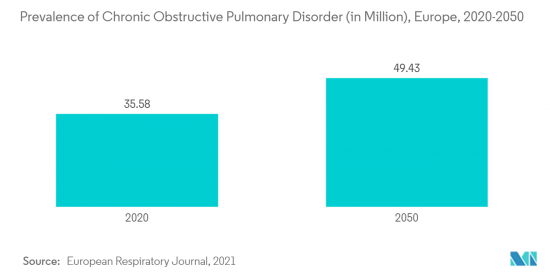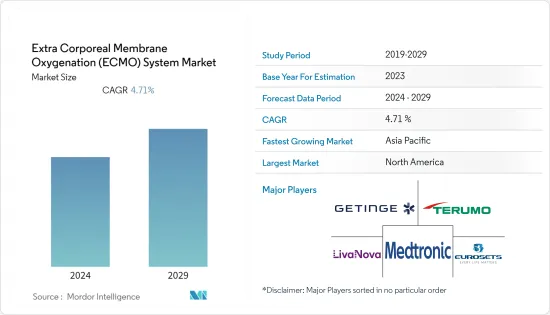
|
市場調査レポート
商品コード
1403825
体外式膜酸素供給(ECMO)システム- 市場シェア分析、産業動向と統計、2024~2029年の成長予測Extra Corporeal Membrane Oxygenation (ECMO) System - Market Share Analysis, Industry Trends & Statistics, Growth Forecasts 2024 - 2029 |
||||||
カスタマイズ可能
適宜更新あり
|
|||||||
| 体外式膜酸素供給(ECMO)システム- 市場シェア分析、産業動向と統計、2024~2029年の成長予測 |
|
出版日: 2024年01月04日
発行: Mordor Intelligence
ページ情報: 英文 110 Pages
納期: 2~3営業日
|
全表示
- 概要
- 目次
体外式膜酸素供給(ECMO)システム市場は予測期間中にCAGR 4.71%を記録すると予測されます。
COVID-19は市場成長に大きな影響を与えました。例えば、BioMed Centralに掲載された論文によると、2021年9月、COVID-19でECMOをサポートされた患者の死亡率は、パンデミックを通じて世界中で著しく悪化し、ECMOサポートの期間は増加しました。このような予測不可能な結果は、継続的なモニタリング、地域と地域の死亡率、ECMOのサポート期間、とリソースの制限の可能性を理解する必要があった。また、喘息患者における重症COVID-19のリスクは比較的小さかった。それでも、慢性閉塞性肺疾患や間質性肺疾患の患者では、COVID-19による重症化リスクは中程度でした。このように、パンデミックはパンデミック期間中の市場成長に影響を与えました。しかし、規制や貿易障壁が撤廃されたことで、ECMO装置のサプライチェーンが拡大し、市場の成長をさらに後押しすることになった。
心血管疾患や呼吸器疾患の有病率の増加、ECMO技術の技術的進歩、ECMOシステムの採用増加などの要因が、予測期間中の市場成長を押し上げると見られています。
人口の間で呼吸器疾患や心血管疾患の負担が増加しているため、体への酸素供給が不十分となり、ECMOシステムの需要が増加しています。例えば、2021年1月にPLOS One誌に掲載された研究によると、フランスでは約260万人が慢性閉塞性肺疾患(COPD)に罹患していることが確認されており、この数は2025年までに280万人に増加すると予測されています。さらに、オーストラリア統計局が発表した2022年の統計によると、オーストラリアにおける心臓病の有病率は2020~2021年に4.0%で、これは約100万人に相当します。
さらに、病院によるECMO装置の導入が増加し、その需要が高まっていることも、予測期間中の市場成長を促進すると予想されています。例えば、2022年4月にNLMに掲載された論文によると、パンデミック期間中に新生児4万5,205人、小児3万743人、成人7万5,735人を含む15万1,683人の患者がECMO治療を受けたことが確認されています。また、パンデミック期間中に492のセンターと病院がECMO装置を採用しました。
さらに、製品発売の増加により、技術的に先進的なECMOシステムが市場に出回るようになった。これは予測期間中の市場成長を促進すると予想されます。例えば、2021年10月、Getinge社は、Rotaflow II体外式生命維持装置(ECLS)システムと永久生命維持装置(PLS)セットを発売しました。これにより医療スタッフは、質の高い患者ケアを提供するために必要な柔軟性を得ることができます。
したがって、心肺疾患の負担が大きいこと、ECMOシステムの採用が増加していること、製品の発売が増加していることなどの上記の要因により、調査対象市場は予測期間中に成長すると予想されます。しかし、ECMO処置の高コストとECMOシステムに関連するリスクは、予測期間中の体外式膜酸素供給(ECMO)システム市場の成長を阻害する可能性が高いです。
体外式膜酸素供給(ECMO)システム市場動向
呼吸器用途は予測期間中に大幅な成長が見込まれる
体外式膜酸素供給(ECMO)システム市場は、人口の呼吸器疾患負担の増加や企業活動の活発化などの要因から、呼吸器分野が予測期間中に大きく成長するとみられています。
人口の間で喘息、慢性閉塞性肺疾患(COPD)、肺線維症、肺炎、肺がんなどの呼吸器疾患の有病率や発生率が上昇していることが、ECMO装置の需要を促進する主要要因です。例えば、CDCが発表したデータによると、2022年12月、個人の約4.6%が2021年のある時点でCOPD、肺気腫、慢性気管支炎の診断を受けていました。また、2022年8月にERSジャーナルに発表された論文によると、2050年までに約6億4,560万人(男性4億5,440万人、女性1億9,120万人)がCOPDを経験すると予測されており、これは前年と比較して世界の有病率が相対的に36%増加することを示しています。同様に、National Cancer Registry Programmeが発表した2022年の統計によると、2022年にはインドで新たに約10万3,371人の肺がん患者が報告され、前年は9万8,278人でした。
さらに、2022年4月にASAIO Journalに発表された研究によると、8-33人の成人患者がダイナミックECMOまたはハイブリッドECMOを使用していました。その主要診断は、心原性ショック(33.7%)、心停止(6.0%)、急性呼吸不全(39.8%)、敗血症性ショック(9.6%)、多発外傷(3.6%)、肺高血圧症(3.6%)、その他(3.6%)でした。またこの研究では、体外膜酸素療法(ECMO)は患者の生理的状態や臨床的状態が変化した場合に、ダイナミックな構成やハイブリッドな構成が必要になると結論づけています。したがって、生理学的または臨床的条件の変化時に膜酸素化装置の採用が増加することは、予測期間にわたって調査市場の成長を後押しすると予想されます。
さらに、製品発売の増加も同分野の成長に寄与しています。例えば、2022年11月、LivaNova PLCは体外式膜酸素供給(ECMO)の米国FDA承認を取得しました。LifeSPARCは、心肺バイパス用の次世代高度循環補助(ACS)ポンプとコントローラーシステムです。
したがって、呼吸器疾患の負担が大きいこと、ECMOシステムの採用が拡大していること、製品上市が増加していることなどの上記の要因から、調査対象セグメントは予測期間中に成長すると予想されます。

予測期間中、北米が大きな市場シェアを占める見込み
北米は、心血管疾患と呼吸器疾患の有病率の増加、ECMO技術の進歩、ECMOシステムの採用増加により、予測期間中に大きな市場シェアを占めると予想されます。
高血圧、肥満、2型糖尿病、食生活の乱れなど、心血管疾患とそれに関連する危険因子の負担増は、人口の慢性心疾患発症リスクを高め、市場成長を後押ししています。例えば、IDFが発表した2022年の統計によると、カナダでは2021年に約290万人が糖尿病と共存していました。さらに、同出典によると、この数は2030年までに320万人、2045年までに340万人に達すると予測されています。そのため、糖尿病による高血糖は、心臓や血管をコントロールする神経を傷つけ、冠動脈疾患や脳卒中などの心血管疾患を引き起こし、動脈を狭め、冠動脈バイパス手術が必要となります。こうした処置には生命維持装置が必要であり、ECMO装置の需要を高め、市場拡大に拍車をかけると予測されます。
また、高齢者人口が増加しているため、心肺疾患を発症しやすく、手術につながる可能性があります。これがECMOシステムの需要を高め、予測期間中の市場成長を促進します。例えば、UNPFが発表した2022年の統計によると、米国とカナダの人口の約17%と19%が2022年に65歳以上になります。
さらに、カナダ政府が発表した2022年の統計によると、カナダでは2021年に12歳以上の人口約383万200人が現在喫煙者、毎日喫煙者、または時々喫煙者でした。また、WHOが発表した2022年の統計によると、ウェストバージニア州の喫煙率は23.8%と最も高く、ケンタッキー州の23.6%、ルイジアナ州の21.9%、オハイオ州の20.8%がこれに続く。このように、この地域では喫煙者が多く、COPDなど様々な肺疾患を発症するリスクが高いです。その結果、呼吸器生命維持装置の需要が高まり、市場の成長を後押ししています。
さらに、新製品の発売や承認が増加していることも、同地域の市場成長に寄与しています。例えば、2022年7月、Inspira Technologies社は、生命を脅かす心不全や肺不全の患者を治療するために使用される高度な形態の生命維持装置体外式膜酸素供給(ECMO)であるLibyシステムを明らかにしました。このシステムは2023年前半に米国食品医薬品局(FDA)に承認申請される予定です。
したがって、心血管疾患や呼吸器疾患の負担が大きいこと、製品の上市が増加していることなどの上記の要因により、調査対象市場は予測期間中に成長すると予想されます。
体外式膜酸素供給(ECMO)システム産業概要
体外式膜酸素供給(ECMO)システム市場は競争が激しく、複数の主要企業が参入しています。市場の主要企業には、LivaNova(Alung Technologies Inc.)、Eurosets、Getinge AB、Medtronic PLC、Microport Scientific Corporation、Nipro Medical Corporation、Terumo Medical Corporation、Abbott Laboratories、Fresenius Medical Care Company(Xenios AG)などがあります。
その他の特典:
- エクセル形式の市場予測(ME)シート
- 3ヶ月間のアナリスト・サポート
目次
第1章 イントロダクション
- 調査の前提条件と市場定義
- 調査範囲
第2章 調査手法
第3章 エグゼクティブサマリー
第4章 市場力学
- 市場概要
- 市場促進要因
- 心血管疾患と呼吸器疾患の有病率の増加
- ECMO技術の技術的進歩
- ECMOシステムの採用増加
- 市場抑制要因
- ECMO手技の高コスト
- ECMOシステムに伴うリスク
- ポーターのファイブフォース分析
- 供給企業の交渉力
- 買い手/消費者の交渉力
- 新規参入業者の脅威
- 代替品の脅威
- 競争企業間の敵対関係の強さ
第5章 市場セグメンテーション(市場規模-米ドル)
- モダリティ別
- 血管動脈(VA)
- 静脈(VV)
- その他
- 用途別
- 呼吸器用途
- 心臓用途
- 体外心肺蘇生法(ECPR)
- 地域別
- 北米
- 米国
- カナダ
- メキシコ
- 欧州
- ドイツ
- 英国
- フランス
- イタリア
- スペイン
- その他の欧州
- アジア太平洋
- 中国
- 日本
- インド
- オーストラリア
- 韓国
- その他のアジア太平洋
- 中東・アフリカ
- GCC諸国
- 南アフリカ
- その他の中東とアフリカ
- 南米
- ブラジル
- アルゼンチン
- その他の南米
- 北米
第6章 競合情勢
- 企業プロファイル
- LivaNova(Alung Technologies Inc.)
- Eurosets
- Getinge AB
- Medtronic PLC
- Microport Scientific Corporation
- Inspira Technologies
- Terumo Medical Corporation
- Abbott Laboratories
- Fresenius Medical Care Company(Xenios AG)
第7章 市場機会と今後の動向

The extracorporeal membrane oxygenation (ECMO) system market is projected to register a CAGR of 4.71% over the forecast period.
COVID-19 significantly impacted the market growth. For instance, according to an article published in BioMed Central, in September 2021, mortality for ECMO-supported patients with COVID-19 significantly worsened worldwide throughout the pandemic, and the duration of ECMO support increased. These unpredictable results necessitated ongoing monitoring, understanding of local and regional death rates, the length of ECMO support, and possible resource limitations. Also, the risk of severe COVID-19 in people with asthma was relatively small. Still, people with chronic obstructive pulmonary disorders and interstitial lung disease had a moderate risk of severe disease due to COVID-19. Thus, the pandemic impacted market growth during the pandemic. However, with removed restrictions and trade barriers, the supply chain of ECMO machines increased, further propelling the market growth.
Factors such as the increasing prevalence of cardiovascular and respiratory diseases, technological advancements in ECMO technology, and increased adoption of ECMO systems are expected to boost market growth over the forecast period.
The increasing burden of respiratory and cardiovascular disease among the population increased the demand for ECMO systems due to insufficient oxygen supply to the body. For instance, according to the study published in the PLOS One journal in January 2021, it was observed that about 2.6 million people were suffering from chronic obstructive pulmonary disease (COPD) in France, and this number is expected to rise to 2.8 million by 2025. Additionally, according to the 2022 statistics published by the Australian Bureau of Statistics, the prevalence of heart disease in Australia was 4.0% in 2020-2021, which equates to about 1 million people.
Furthermore, hospitals' rising adoption of ECMO machines increased their demand, which is also expected to fuel the market growth over the forecast period. For instance, as per an article published in NLM in April 2022, it was observed that 151,683 patients, including 45,205 newborns, 30,743 children, and 75,735 adults, received ECMO treatment during the pandemic period. In addition, 492 centers and hospitals adopted ECMO machines during the pandemic.
Moreover, the rising product launches increase the availability of technologically advanced ECMO systems in the market. It is expected to fuel the market growth over the forecast period. For instance, in October 2021, Getinge launched the Rotaflow II Extracorporeal Life Support (ECLS) System with the Permanent Life Support (PLS) Set, which offers up to 14 days of cardiopulmonary support in a compact, portable, safe, and reliable manner. It gives healthcare staff the flexibility they need to provide quality patient care.
Therefore, the studied market is expected to grow over the forecast period due to the factors above, such as the high burden of cardiopulmonary diseases, the growing adoption of ECMO systems, and increasing product launches. However, the high cost of ECMO procedures and the risk associated with ECMO systems will likely impede the growth of the extracorporeal membrane oxygenation (ECMO) system market over the forecast period.
Extra Corporeal Membrane Oxygenation (ECMO) System Market Trends
Respiratory Applications is Expected to Witness Significant Growth Over the Forecast Period
The respiratory segment is expected to witness significant growth in the extracorporeal membrane oxygenation (ECMO) system market over the forecast period owing to factors such as the increasing burden of respiratory diseases among the population and growing company activities.
The rising prevalence and incidence of respiratory diseases, such as asthma, chronic obstructive pulmonary disease (COPD), pulmonary fibrosis, pneumonia, and lung cancer, among the population is the key factor driving the demand for ECMO machines. For instance, according to the data published by the CDC, in December 2022, about 4.6% of individuals had received a COPD, emphysema, or chronic bronchitis diagnosis at some point in 2021. Also, according to an article published in ERS Journal in August 2022, it was projected that about 645.6 million people (454.4 million men and 191.2 million women) are expected to experience COPD by 2050, representing a 36% relative increase in global prevalence as compared to the previous year. Similarly, according to the 2022 statistics published by the National Cancer Registry Programme, about 1,03,371 new lung cancer cases were reported in India in 2022 as compared to 98,278 during the last year.
Furthermore, as per the study published in ASAIO Journal in April 2022, it was observed that eight-three adult patients had dynamic or hybrid ECMO configurations. Their primary diagnoses included cardiogenic shock (33.7%), cardiac arrest (6.0%), acute respiratory failure (39.8%), septic shock (9.6%), multiple trauma (3.6%), pulmonary hypertension (3.6%), and others (3.6%). Also, the study concluded that dynamic or hybrid configurations for extracorporeal membrane oxygenation (ECMO) are needed when patient physiology or clinical conditions change. Thus, the increasing adoption of membrane oxygenators during physiological or clinical conditions change is expected to boost the growth of the studied market over the forecast period.
Moreover, the rising product launches are also contributing to segment growth. For instance, in November 2022, LivaNova PLC received the United States FDA approval for its extracorporeal membrane oxygenation (ECMO). LifeSPARC is a next-generation Advanced Circulatory Support (ACS) pump and controller system for cardiopulmonary bypass.
Therefore, the studied segment is expected to grow over the forecast period due to the factors above, such as the high burden of respiratory diseases, the growing adoption of ECMO systems, and increasing product launches.

North America is Expected to include the Significant Market Share Over the Forecast Period
North America is expected to hold a significant market share over the forecast period owing to its increasing prevalence of cardiovascular and respiratory diseases, advancements in ECMO technology, and increased adoption of ECMO systems.
The increasing burden of cardiovascular diseases and their associated risk factors, such as high blood pressure, obesity, type-2 diabetes, and poor dietary habits, increased the population's risk of developing chronic heart diseases, propelling market growth. For instance, as per 2022 statistics published by IDF, about 2.9 million people were living with diabetes in 2021 in Canada. In addition, as per the same source, this number is projected to reach 3.2 million by 2030 and 3.4 million by 2045. Therefore, high blood sugar caused by diabetes can damage the nerves that control the heart and blood vessels, leading to cardiovascular diseases like coronary artery disease and stroke, narrowing the arteries and necessitating coronary artery bypass procedures. These procedures call for life support systems, projected to enhance demand for ECMO machines and spur market expansion.
In addition, the increasing geriatric population is more prone to developing cardiopulmonary diseases, which may lead to surgeries. It increases the demand for ECMO systems, fueling the market growth over the forecast period. For instance, as per 2022 statistics published by UNPF, about 17% and 19% of the United States and Canadian population was 65 years and above in 2022.
Furthermore, as per 2022 statistics published by the Government of Canada, about 3,830,200 population aged 12 years and over were current, daily, or occasional smokers in Canada in 2021. Also, as per 2022 statistics published by WHO, West Virginia includes the highest smoking rate at 23.8%, followed by Kentucky at 23.6%, Louisiana at 21.9%, and Ohio at 20.8% in 2022. Thus, the high number of smokers in the region are at high risk of developing various lung diseases such as COPD. It, in turn, raises the demand for respiratory life support systems, hence propelling the market growth.
Moreover, the growing number of new product launches and approvals are also contributing to the market growth in the region. For instance, in July 2022, Inspira Technologies revealed its Liby System, an advanced form of life support extracorporeal membrane oxygenation (ECMO) used to treat patients with life-threatening heart and lung failure. The system is expected to be submitted to the United States Food and Drug Administration (FDA) for approval during the first half of 2023.
Therefore, the studied market is expected to grow over the forecast period due to the above factors, such as the high burden of cardiovascular and respiratory diseases and increasing product launches.
Extra Corporeal Membrane Oxygenation (ECMO) System Industry Overview
The extracorporeal membrane oxygenation (ECMO) system market is competitive and includes several key players. Some of the key companies in the market are LivaNova (Alung Technologies Inc.), Eurosets, Getinge AB, Medtronic PLC, Microport Scientific Corporation, Nipro Medical Corporation, Terumo Medical Corporation, Abbott Laboratories, and Fresenius Medical Care Company (Xenios AG) among others.
Additional Benefits:
- The market estimate (ME) sheet in Excel format
- 3 months of analyst support
TABLE OF CONTENTS
1 INTRODUCTION
- 1.1 Study Assumptions and Market Definition
- 1.2 Scope of the Study
2 RESEARCH METHODOLOGY
3 EXECUTIVE SUMMARY
4 MARKET DYNAMICS
- 4.1 Market Overview
- 4.2 Market Drivers
- 4.2.1 Increasing Prevalence of Cardiovascular and Respiratory Diseases
- 4.2.2 Technological Advancements in ECMO Technology
- 4.2.3 Increased Adoption of ECMO Systems
- 4.3 Market Restraints
- 4.3.1 High Cost of ECMO Procedures
- 4.3.2 Risks Associated with ECMO System
- 4.4 Porter's Five Forces Analysis
- 4.4.1 Bargaining Power of Suppliers
- 4.4.2 Bargaining Power of Buyers/Consumers
- 4.4.3 Threat of New Entrants
- 4.4.4 Threat of Substitute Products
- 4.4.5 Intensity of Competitive Rivalry
5 MARKET SEGMENTATION (Market Size by Value - USD)
- 5.1 By Modality
- 5.1.1 Veno-Arterial (VA)
- 5.1.2 Veno-Venous (VV)
- 5.1.3 Others
- 5.2 By Application
- 5.2.1 Respiratory Applications
- 5.2.2 Cardiac Applications
- 5.2.3 Extracorporeal Cardiopulmonary Resuscitation (ECPR)
- 5.3 Geography
- 5.3.1 North America
- 5.3.1.1 United States
- 5.3.1.2 Canada
- 5.3.1.3 Mexico
- 5.3.2 Europe
- 5.3.2.1 Germany
- 5.3.2.2 United Kingdom
- 5.3.2.3 France
- 5.3.2.4 Italy
- 5.3.2.5 Spain
- 5.3.2.6 Rest of Europe
- 5.3.3 Asia-Pacific
- 5.3.3.1 China
- 5.3.3.2 Japan
- 5.3.3.3 India
- 5.3.3.4 Australia
- 5.3.3.5 South Korea
- 5.3.3.6 Rest of Asia-Pacific
- 5.3.4 Middle East and Africa
- 5.3.4.1 GCC
- 5.3.4.2 South Africa
- 5.3.4.3 Rest of Middle East and Africa
- 5.3.5 South America
- 5.3.5.1 Brazil
- 5.3.5.2 Argentina
- 5.3.5.3 Rest of South America
- 5.3.1 North America
6 COMPETITIVE LANDSCAPE
- 6.1 Company Profiles
- 6.1.1 LivaNova (Alung Technologies Inc.)
- 6.1.2 Eurosets
- 6.1.3 Getinge AB
- 6.1.4 Medtronic PLC
- 6.1.5 Microport Scientific Corporation
- 6.1.6 Inspira Technologies
- 6.1.7 Terumo Medical Corporation
- 6.1.8 Abbott Laboratories
- 6.1.9 Fresenius Medical Care Company (Xenios AG)


